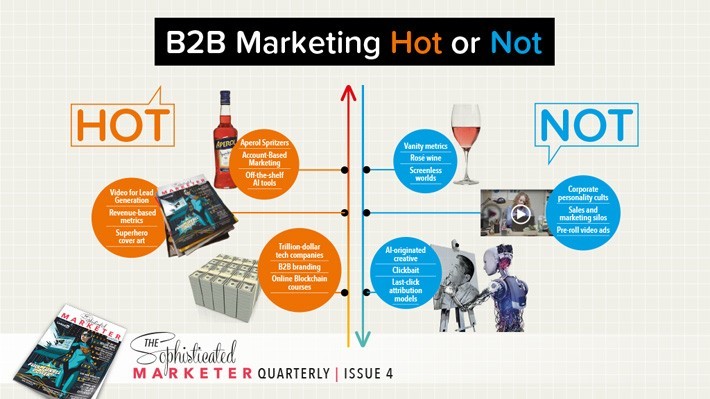What’s Hot and what’s Not in B2B Marketing for 2019
Which ideas, technologies and tactics are flavour of the B2B marketing month as we head into 2019? Which are the platforms and formats to tick off in your plan for the year? Just as importantly, which are the past-their-best buzzwords you should be cutting out of conversation? And most importantly of all, which achingly hip drinks should you be ordering at the bar?
The B2B Marketing Hot or Not gauge is designed to provide the answers to these types of pressing professional questions. It’s published every few months as part of our Sophisticated Marketer Quarterly magazine. In each issue, we pick out the value-adding ideas setting the B2B agenda – and also those sliding out of the spotlight or being called out for the damage they do.
As we head into 2019, here’s the latest edition of our Hot or Not guide, plus our explanation of what’s raising or lowering the temperature for our entries:
The Hot List:
Aperol Spritzers
It arrived from nowhere to elbow aside Pimms as the summer’s must-splash tipple. Then it followed up with cross-over Christmas success as the choice of office party-goers and festive dinner party-throwers. The rise of Aperol was one of the most sensational marketing success stories of last year – and we believe it’s still got some distance to run. Why? Because this wasn’t some surprise viral movement. It was part of a carefully planned portfolio marketing strategy from owner Campari that identified the real growth opportunity in the UK market. When you order a dash of Aperol in your Prosecco, you’re not just refreshing your tastebuds – you’re sipping on a strategic marketing case study.
Account-based Marketing
It’s hard to imagine a hotter B2B marketing tactic than ABM. According to Marketo’s 2017 Marketing Benchmark Report, 34% of marketers have some form of ABM programme in place – and according to Demand Gen Report’s ABM benchmark survey, it’s likely that around half of them launched that programme within the last year. ABM is growing fast because it works (Alterra Group claims that 97% of marketers report higher ROI) – and also because of the transformational effect it can have on broader sales and marketing alignment and B2B marketing measurement. Take a close look at the winners of this year’s LinkedIn Marketing Awards for lead generation and innovation, and you’ll get a sense of what’s possible leveraging LinkedIn data and targeting for ABM.
Off-the-shelf AI tools
Early discussions of Artificial Intelligence and marketing envisaged huge investments in bespoke AI systems that would deliver astonishing competitive advantage to those businesses able to afford them ely. However, that’s not the vision of AI that’s been catching hold over the past few months. At DMEXCO in September, AI pioneers like Axel Steinman at Bing and Karl Bunch of Amazon Web Services stressed the importance of democratising AI: providing off-the-shelf, cost-effective solutions that can be leveraged by any business. Rather than tilting the playing field in B2B marketing, the roll-out of AI could go a long way towards levelling it.
Video for Lead Generation
It’s easy to fall into the assumption that B2B video is a purely upper-funnel format: there to engage people emotionally, generate awareness at scale and build brands. However, the rapid take-up of B2B video on LinkedIn is quickly showing that it can do a lot more. From customer testimonials to how-to videos and product demonstration, marketers are applying tailored B2B video to objectives throughout the funnel.
Revenue-based metrics
The C-suite is demanding that marketing moves closer to business strategy, and the price of this admission to the top table is metrics that have real and obvious relevance to the bottom-line. That’s why CMOs are increasingly demanding revenue-based metrics to prove marketing’s effectiveness. They’re less and less interested in cost per click (CPC) and cost per lead (CPL); more and more interested in value per lead, cost per sale and ultimately, revenue-based ROI.
B2B branding
As marketers look beyond quantity of leads and top-level engagement metrics, they are swiftly rediscovering the value of brands in the B2B buyer journey. Effectively integrating brand activity with demand generation significantly increases the quality and relevance of leads. And in a ‘Content Shock’ era when marketers are battling for attention in social media feeds, brand recognition is becoming an immensely powerful asset. It helps that tools like LinkedIn Conversion Tracking are shedding more light on the contribution that upper-funnel activity makes to eventual sales.
Superhero cover art
Maybe it’s the seemingly unstoppable success of the Marvel movie franchise – or the return of Disney Pixar’s Incredibles. Then again, maybe it’s down to our spectacular, recent Sophisticated Marketer Quarterly cover. Either way, we’re calling it: retro superhero artwork is hot stuff.
Trillion-dollar tech companies
Like London buses, you wait ages for one – and then suddenly three come along at once: Apple, Amazon and Microsoft.
Online Blockchain courses
We’re seeing massive interest in next-generation digital skills on platforms like LinkedIn Learning – and it seems likely that interest in Blockchain will skyrocket over the next year. It’s the subject on the marketing agenda that most marketers know least about. Its potential implications for delivering content and services are massive. There’s opportunity in knowing your Blockchain stuff, precisely because so few people do.
The Not List:
Vanity metrics
Revenue-based metrics don’t just replace vanity metrics. They can often prove how misleading focusing solely on clicks or views can be. If you’re going to report on or optimise around engagement metrics, then make sure you’re keeping a close eye on the real value your engagement represents.
Rosé Wine
Could this finally be the year when marketers break out of the stereotype of heading to the Cannes International Festival of Creativity to swill endless bottles of pink wine? It’s time for Aperol Spritz to take over the Croissette.
Screenless Worlds
A lot of time has been spent speculating on the future of marketing in a ‘screenless world’ where audiences spend their time in conversation with Alexa, Siri or Cortana without ever taking in information visually. It’s looking like a lot of that time has been wasted. The companies building virtual digital assistants don’t envisage them doing away with screens entirely – and with good reason. Neuroscience shows that, not only can we process visual information faster, but we remember it far better as well. Living without screens would severely restrict how productive we could be.
Corporate personality cults
There’s always been a steady supply of professional content that excitedly shares words of wisdom from corporate celebrities. However, some high-profile falls from grace over the past 18 months have left this form of B2B hero-worship feeling a lot less credible. Better to elevate your own thought-leaders and experts than treat others reverentially as the source of all wisdom.
Sales and marketing silos
They’re an endangered species like never before: in the sights of digital transformation programmes, social selling, sales and marketing alignment initiatives and ABM strategies. Is there ever an argument for sales and marketing silos? It’s increasingly difficult to imagine one.
Pre-roll video ads
At a time when spend on in-feed native video content is doubling year-on-year according to PwC and IAB UK, pre-roll video ad formats are on the retreat. They’re simply too interruptive and too ineffective with audiences increasingly frustrated at sitting through even a few seconds. According to Nielsen, native video in the feed delivers engagement and view rates 82% higher.
AI-originated creative
AIs have replicated the works of Rembrandt and other great masters, contributed to writing West End musicals and come up with catchy pop tunes. However, they are still nothing like as effective at producing original creative ideas than human beings themselves. And their fundamental lack of empathy and nuanced cultural understanding probably means they never will be. AI pioneers like Karl Bunch talk enthusiastically about capturing new forms of data that can inform and optimise human creativity – but they are far too smart to claim that machines can take over the creative process entirely.
Clickbait
It will always exist – but there’s no reason why any serious marketer interested in results of real relevance and value should ever engage in it.
Last click attribution models
As B2B buyer journeys become longer and more complex, last-click attribution seems less and less sane. Accessible analytics technologies like the LinkedIn Insight Tag mean B2B marketers are running out of excuses for relying on it.
Topics: Content marketing Trends, tips, and best practices LinkedIn Ads
Related articles



